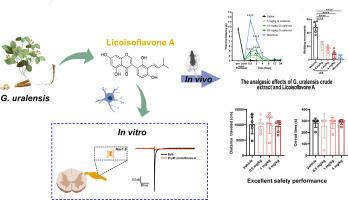Glycyrrhiza uralensis Fisch: A novel source of analgesic activity through NaV1.8 sodium channel modulation
IF 8
1区 农林科学
Q1 FOOD SCIENCE & TECHNOLOGY
引用次数: 0
Abstract
Glycyrrhiza uralensis Fisch. (G. uralensis) is a “medicine food homology” herbal medicine widely used in the pharmaceutical and food industries. G. uralensis has a variety of biological functions, including antioxidant, antiviral, anti-inflammation and analgesic effects. However, the specific mechanism underlying the pain-relieving effects of G. uralensis remains to be explored. Here we investigated the analgesic properties of G. uralensis using rodent models of pain. The crude extracts of G. uralensis effectively alleviated acetic acid-induced inflammatory and paclitaxel-induced neuropathic pain. Further screening studies identified licoisoflavone A as the key bioactive compound of G. uralensis responsible for its analgesic activity, which inhibits the NaV1.8 sodium channel (IC50 = 7.53 μM). Combining electrophysiological experiments with molecular docking revealed that licoisoflavone A acts as a novel, highly potent pore blocker of the NaV1.8 channel by obstructing ion flow through the pore region. Moreover, in various murine pain models, licoisoflavone A showed a significant dose-dependent analgesic effect in reducing inflammatory and neuropathic pain, including those pain models induced by acetic acid, heat, complete Freund's adjuvant, and paclitaxel. Cell cytotoxicity assays, open-field tests, and rotarod tests confirmed licoisoflavone A exhibits a favorable safety profile. Our study uncovers the underlying mechanism of G. uralensis analgesia and suggests that licoisoflavone A is a promising candidate for targeting NaV1.8 for pain therapy.

乌拉尔甘草:通过NaV1.8钠通道调节镇痛活性的新来源
乌拉尔甘草乌拉尔草(G. uralensis)是一种“药食同源”的草药,广泛应用于制药和食品工业。乌拉尔草具有多种生物学功能,包括抗氧化、抗病毒、抗炎和镇痛作用。然而,其镇痛作用的具体机制仍有待探索。在此,我们利用啮齿动物疼痛模型研究了乌拉尔草的镇痛特性。乌拉尔草粗提物能有效缓解醋酸诱导的炎症和紫杉醇诱导的神经性疼痛。进一步的筛选研究发现,甘草异黄酮A是乌拉尔草镇痛活性的关键生物活性化合物,可抑制NaV1.8钠通道(IC50 = 7.53 μM)。结合电生理实验和分子对接发现,licoisoflavone A是一种新型的、高效的NaV1.8通道孔阻滞剂,可阻断离子通过孔区。此外,在各种小鼠疼痛模型中,甘草异黄酮A显示出明显的剂量依赖性镇痛作用,可以减轻炎症性和神经性疼痛,包括醋酸、热、完全弗氏佐剂和紫杉醇引起的疼痛模型。细胞毒性试验、露天试验和轮轮试验证实,甘草异黄酮A具有良好的安全性。我们的研究揭示了乌拉尔野鼠镇痛的潜在机制,并提示licoisoflavone A是靶向NaV1.8疼痛治疗的有希望的候选物。
本文章由计算机程序翻译,如有差异,请以英文原文为准。
求助全文
约1分钟内获得全文
求助全文
来源期刊

Food Research International
工程技术-食品科技
CiteScore
12.50
自引率
7.40%
发文量
1183
审稿时长
79 days
期刊介绍:
Food Research International serves as a rapid dissemination platform for significant and impactful research in food science, technology, engineering, and nutrition. The journal focuses on publishing novel, high-quality, and high-impact review papers, original research papers, and letters to the editors across various disciplines in the science and technology of food. Additionally, it follows a policy of publishing special issues on topical and emergent subjects in food research or related areas. Selected, peer-reviewed papers from scientific meetings, workshops, and conferences on the science, technology, and engineering of foods are also featured in special issues.
 求助内容:
求助内容: 应助结果提醒方式:
应助结果提醒方式:


